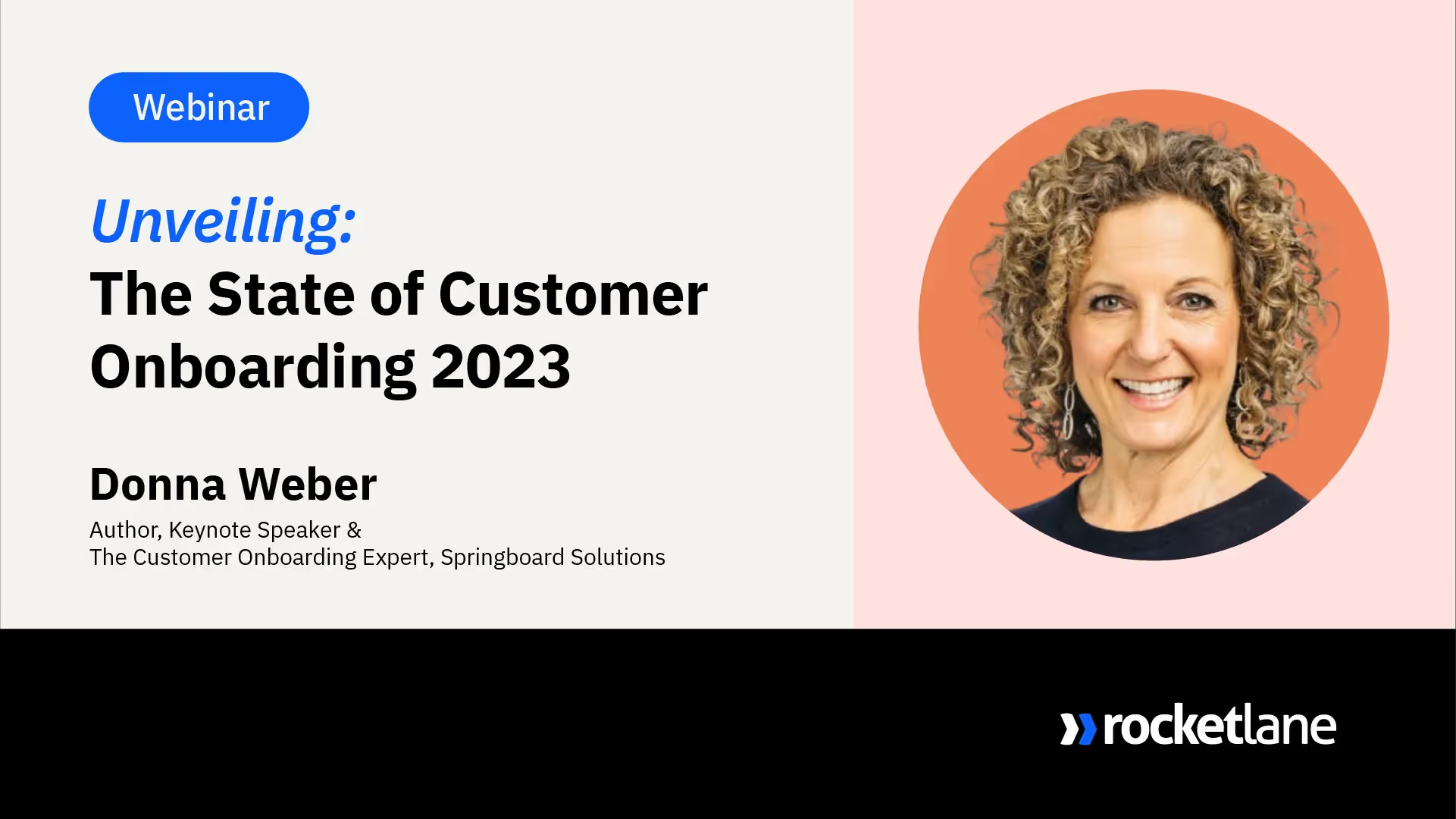In 2022, we launched the State of Customer Onboarding report, the world's first and only report dedicated to improving the understanding of the customer onboarding process, function, and workforce.
In the 2023 installment, we continue to drive dialogue around practices and challenges in customer onboarding while adding a layer of emerging trends and insights.
Donna Weber, customer onboarding expert and author of the award-winning book Onboarding Matters joined Srikrishnan Ganesan, CEO & co-founder of Rocketlane, to discuss findings and insights from the report.
About the State of Customer Onboarding 2023 report
Rocketlane spoke to 300+ customer onboarding and implementation professionals across different industries, verticals, and organization sizes in the SaaS and technology industry to uncover customer onboarding goals, challenges, and trends for 2023.
Get your copy of the complete report here.
In this session, Donna and Srikrishnan discussed:
1. Why customer onboarding is key to navigating today’s challenging market conditions
2. Findings and trends in the State of Customer Onboarding 2023 report, such as:
- Customer onboarding maturity
- The emergence of the onboarding team
- How the ‘do more with less’ trend is playing out in customer onboarding
- Packaging customer onboarding
- Top customer onboarding goals, challenges, and problems
3. Insights and anecdotes from the industry
4. Recommendations on the above
Here are snippets from the conversation between Sri, CEO & co-founder of Rocketlane, and Donna.
We’ve edited the conversation for brevity and clarity.
Why customer onboarding matters now more than ever
Sri: With the fall in the SaaS multiples, the state of the economy, the fact that we’re going into a few quarters where spending is going to be muted, and with all budgets being examined, we are in tough times.
And we believe that customer onboarding matters more than ever before. For every new customer you bring in, you've had them convince their leadership to buy your software. And now, it’s super important that you actually get them to value – or churn is going to be immediate, given the current environment.
So I think that's my big lesson for this year.
This is the year when the post-sale functions are all going to be super critical. We need to build strong relationships with every new customer we bring on. And we need to focus on getting them to expand after seeing value.
Donna: Absolutely. Customer onboarding matters more than ever. And growth happens with your existing customers. So I challenge you to look at how you can onboard your existing customers – because that's where the growth is happening.
You need to demonstrate the impact you’re having – to your customers and to your leaders in very clear ways. As customer-facing teams, we can't just say that we've onboarded X number of accounts or that we've been in Y number of meetings this week.
We have to show that what we're doing is better, faster, making and saving more money – for the sake of our industry, jobs, customers, and companies.
We need to show the impact on the bottom line.
Customer onboarding maturity
Donna: With customer onboarding, we typically have four stages:
- Reacting - where everything's urgent, and you're waiting till there are problems. Also, everyone's doing their own thing.
- Performing - where you start to create consistent, repeatable approaches to how you're going to onboard/implement and engage customers.
- Scaling - where you leverage technology to deliver with a one-to-many approach.
- Optimizing - where you can demonstrate your impact on the business's bottom line.
Customer Success 1.0 and Customer Onboarding 1.0 were more of this reactive approach, and 2.0 is where we're creating consistent, repeatable approaches and leveraging technology like Rocketlane to help us move into the Performing and Scaling stages.
Sri: Over the last few years, experts and companies in this space have raised awareness around how customer onboarding is a separate function and the need to be proactive. And it's not surprising to see many folks talk about them being on the Performing or Scaling side.

Donna: I generally like to see all customer-facing teams under the same umbrella because that will help them work together. Also, it depends on what makes sense. As companies grow, teams tend to specialize more rather than having, say, a CSM doing everything for everyone.
Sri: And it's also good to see that there is a well-defined function, which probably means there are specific metrics and that the team is being measured on specific practices they're putting in place, etc.
The customer onboarding function
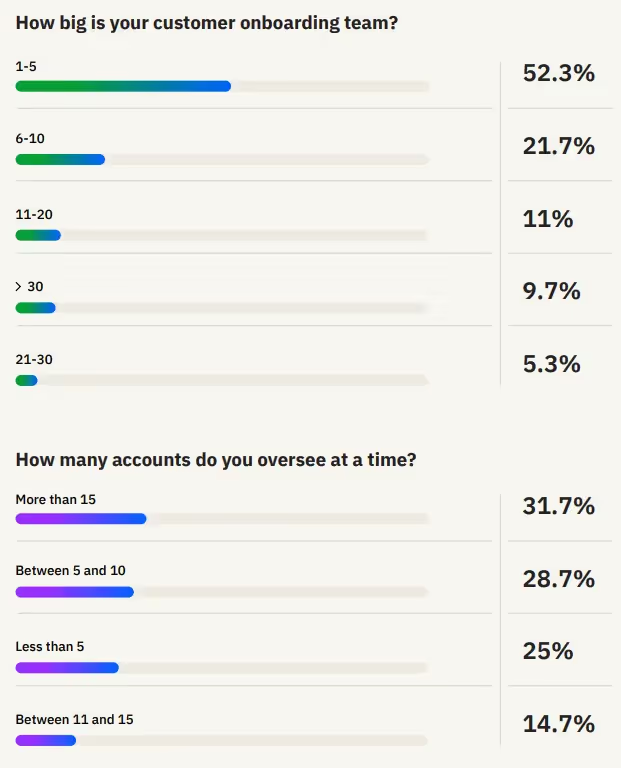
Sri: We also asked people how many accounts each onboarding specialist oversees or manages at a time. And we compared the data we had from 2022 and 2023.
Interestingly, it looks like the ‘more with less’ mantra is represented here on these graphs.
We can see that the number of teams that were managing five to 10 accounts – which seems reasonable – has decreased from 2022.
At the same time, the percentage of teams onboarding more than 15 accounts in parallel has increased from 18% to 31%.
Donna, what would you say is the right number there?
Donna: There's no right number. It really depends.
I would actually ask: Are you delivering the right touch to the right users at the right time?
What I'm seeing is that a lot of companies are delivering the same touch to all their customers. And there's this huge opportunity to segment.
One company I'm working with is spending so much money to onboard and enable new customers, irrespective of whether they are spending $1,000 or $90,000. They’re spending the same amount of time and money with all their customers. And they're losing money on these smaller companies. So they need to find a way to deliver a self-paced journey or a much lower touch, and then somebody could manage maybe even 100 accounts.
So it's more about what's important. I see companies spending so much time getting their customers to go live that they're delaying revenue.
They're delaying profits, eroding margin – and that's what's more important to me than how many accounts you have – because as your company matures, you better be providing that right touch so that you are not losing money and are delivering.
Sri: Absolutely. And I think one of the patterns you've seen in Customer Success, clearly emerging as super important, is that scale motion.
There's a lot of buzz around how you do tech touch, digital scaling, and CS. We'll see a lot of that in customer onboarding this year for the smaller accounts.
We need to put in place learning academies and invest in one-to-many motions. That will benefit a lot of companies, which today, as you said, are spending disproportionate time onboarding different kinds of customers.
Donna: We also get very focused on our high-touch, low-touch, and tech-touch, but what about a hybrid touch?
For example, I've worked with companies where we delivered a digital journey for onboarding but plugged in high-touch moments to make sure customers are getting to value and not just dropping off.
On the other hand, I've worked with a big data company in the UK, where it's a very high-touch, white-glove treatment. But we plugged in some self-paced courses – to scale that team and allow the CSMs and, in this case, their data scientists ( they're called technical success managers) to be those technical experts and focus on what's unique for every customer –
rather than doing basic, repeatable stuff over and over. The more specialized they can be, the more job satisfaction they'll have.
So besides helping your customers, it's also going to help your employees. I'm all about having a hybrid touch.
Packaging and charging for customer implementations
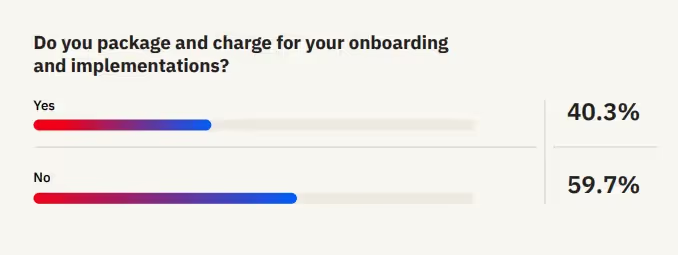
Sri: We asked our respondents if they package and charge for onboarding and implementations.
40% said yes. 60% said no.
I expect more respondents will say yes when we do the same survey at the end of 2023.
Last year, we charged for implementations at Rocketlane, but not consistently (it became almost a negotiation with many customers based on their contract size, and so on).
What we realized is that it helps the customer and us when we charge for implementations because we’re able to bring the right seriousness into the engagement and dedicate more resources to it.
It also forces us to level up in that function. If we need to present a customer with a package, we need to:
- Put together a sales enablement asset around it
- Provide it to the sales team, and get them to share it with the customer
and as a result, the customer is more likely to understand the value being delivered.
This way, the customer takes onboarding seriously and understands the constraints around the timeline you have for onboarding them.
Ultimately, because of the seriousness and intensity that this brings into the engagement, we have a better way to make them successful.
So I think we're doing everyone a favor by charging the customer for onboarding.
Donna: I violently agree!
There are a few things here. Companies are used to charging for, and customers are used to paying for premium support, upgrades, maintenance, etc.
So now's the time to create a ‘happy meal’ where customers have everything they want to succeed. You just bundle it all in – training, dedicated Customer Success, Onboarding, Implementation, etc.
I like to do it as a recurring revenue, not just as a one-off thing. When customers pay for that, as Sri was saying, customers are much more accountable.
I see that in companies I work with. Customers show up for meetings, won’t ghost you, and will do what they promise–because they paid for it.
You don't need to make much money as an onboarding/implementation team, but if you cover your costs, you will move away from being seen as a cost center. And in times like these, we can see what's happening with cost centers.
CFOs and financial teams are looking at where they can cut costs. But if you're bringing in revenue, then you're going to be able to say, ‘Look, we have a budget, we can invest in tools like Rocketlane, we can invest in experts to really get to the next level’.
I’m working with a company where we're defining standard and premium packages because, at the moment, they do anything customers ask for. It's taking them months and costing them thousands of dollars to go live with a client.
And then the next thing to consider is that you need to stay within the boundaries of those packages. You can't discount them. You can't just say, “Oh well, you bought the standard package, but I'll do all this stuff for you anyway”. You have to stick to those guidelines.
Sri: Donna, I’m curious about how you create recurring packages in general and what’s worked well for companies.
Donna: Companies don't want to be nickeled and dimed.
Let's say I signed you up to be my new personal trainer, and we're going to work out together once a week. You could ask me to buy something every week I meet with you. Say, dumbbells one week, stretchy bands the next week, and a roller after that, and then maybe some protein powder another week.
Or you could instead create a package and say, “Hey, here's everything you need. I guarantee when you have this whole package, it's going to help you take your fitness to the next level".And then, ideally, it's recurring.
Many companies I work with have a huge turnover in their customer user base, and actual users, or they have a land-and-expand approach where they onboard and enable that initial group. But nobody else gets any love.
And so, when you have a subscription, whoever gets onboarded gets training. So you might have ongoing performance tuning, health checks, etc.
There are all sorts of things that you can do in a subscription, and then you're adding recurring revenue to your company, which they're going to love. I've done that at companies, and the board and the executives love it.
In my book, I have a whole chapter (Chapter 14) dedicated to creating premium packages.
Customer onboarding and implementation goals
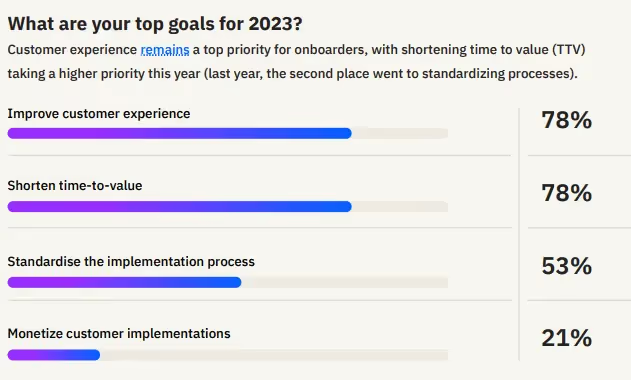
Sri: We asked respondents what their top implementation goals were for 2023.
This year, many people picked shortening time to value as an important goal.
Improving customer experience remains on top, but it's now tied with shortening time to value–if you're shortening time to value, that aids in improving the customer experience.
But in general, what we've seen and heard from customers is that when they are more professional during that initial partnership, customers tend to reciprocate that professionalism.
So you bring your A-game, and the customer is forced to mirror what you're doing with them–that will help the project move faster and help you shorten the time to value as well.
Of course, it's the beginning of the partnership, so hopefully, what this means is that you automatically get them to value faster, they have a better experience, and they trust you, and build confidence in your abilities early as a partner.
And that's what's going to bring expansion into your business.
Customer onboarding challenges
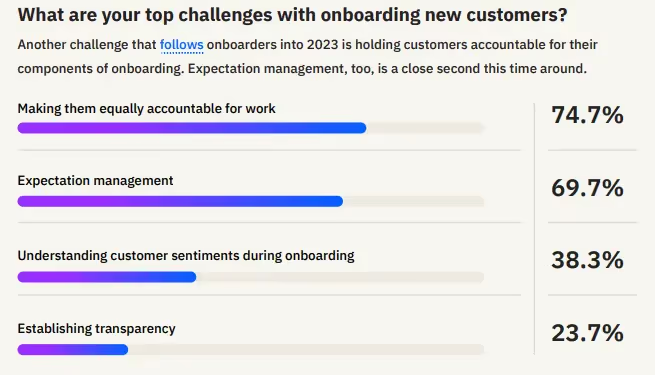
Sri: It’s not surprising that the top answer was making customers equally accountable for the work.
When customers are ghosting you or not getting their part of the work done on time, it's because they haven't actually bought into the fact that there will be value. They haven't seen that sliver of value already being delivered.
It's also because often working with your POC to get onboarded is often a second job for a lot of people. And that's something I wish the buyers change–that they make working with us an OKR for the person involved at their end.
If they have more time to work with us during that phase, it will help everyone.
Expectation management is #2 and understanding customer sentiments is #3; there's a huge bump compared to last year.
Donna: I think that there are huge opportunities here, too. I'm not saying this just because I'm presenting with Rocketlane, but a lot of this can be improved with onboarding software tools.
Customers are going to see where they're accountable, and you can help them understand the journey ahead, set expectations, and that's going to ensure there's transparency.
Sri: I've seen something which helps with the internal transparency as well. When you're using a project management tool or an onboarding tool like Rocketlane, you can do those reviews right there.
As onboarding managers, we often think and hope we can turn the situation around before the next meeting or before the duration of the onboarding runs through. But it will only get worse if you're in a bad position today. You need to highlight the risk, bring in someone, or escalate earlier than later. This is something we've learned the hard way.
The real cost of customer onboarding problems
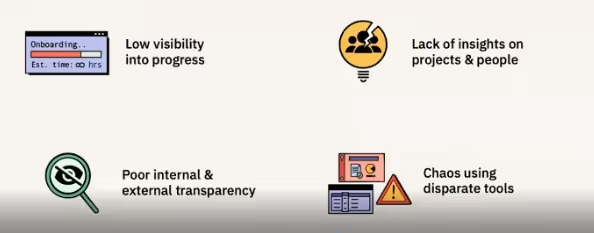
Sri: This is something you've been talking about, Donna: the real cost of customer onboarding.
I think there's a variety of things to look at here.
There is no visibility into progress when you have onboarding problems, which results in poor onboarding.
There is poor internal and external transparency, so leaders on both sides aren't necessarily aware that they need to act upon something or ask hard questions to someone on each side.
And when we don't have patterns from all the onboarding projects we're doing, we don't have the insights to tweak or iterate on our process. Today, we're using various tools, and work and conversations are siloed.
Donna: I often see companies and their customer onboarding/implementation using tools. These may include project management tools, maybe Asana, Smartsheet, Monday, JIRA, or even Google Sheets. And while it’s great that they've defined some processes, they only see them in a very siloed way – one account at a time. And while that might help them manage that account, there’s a gap.
As onboarding specialists, we need to run customer onboarding like a business. And as business owners, we can’t just deal with one account at a time.
We need tools to help us hit that optimized stage of maturity where we can view backlogs or patterns and learn, optimize, improve, and keep customers accountable. I think there's just a huge opportunity to mature our whole industry by having some of those data-driven insights.
Automation and tooling
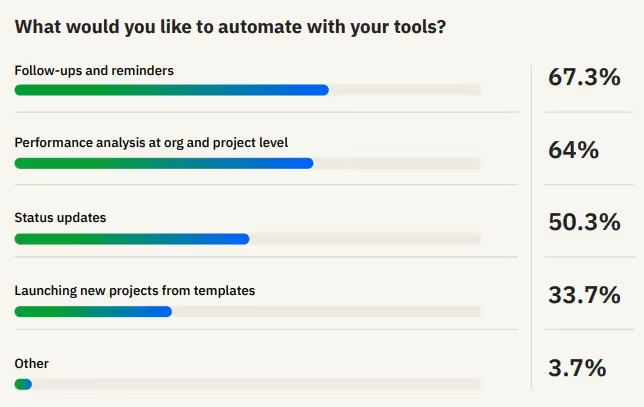
Sri: We asked people what they wanted to automate with their tools.
#1 was follow-ups and reminders. People don't want to spend time following up internally with their teams and externally with the customer. It's a waste of everyone's time.
#2 was performance analysis. You want data, and you don't want to have to do manual data crunching, exporting, etc. Instead, you want to have that analysis readily available for you.
#3 was status updates. I know onboarding teams that don't even send these weekly updates, and that's a recipe for disaster.
We feel there are three key areas that all of us want to improve on level upon with respect to customer onboarding – people, process, and technology.
You can’t put a tool like Rocketlane in the mix and expect it to solve your problems automatically. You also need the right folks on the team, the right number of people. For example, as you're scaling, you probably need someone dedicated to customer education and building training modules.
You need a process. And that's where I think we should all read and reread books like Onboarding Matters–so that we are gaining more on the process front and then taking the process and operationalizing it through the right tools.
Donna: I personally like to do things manually first, so I know what kind of technology I need. For example, I implemented a learning management system for my Orchestrated Onboarding masterclass.
I really wanted to understand what basic repeatable things I ended up doing over and over again. That helped me define my requirements and see exactly what I needed in a tool. And then, I can make sure that with the technology I use, I end up getting data-driven insights so that I can keep taking my team and customers to the next level.
Sri: We also tried to understand the top distractions for teams. And the first and second came up as internal and external follow-ups and tracking work across tools.
Today we're using Slack, shared channels, email, documents, and project plans. This means our work is spread across different tools we need to stay on top of.
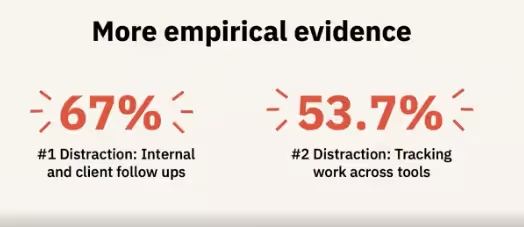
Donna: Post-sales teams need to get much more sophisticated around the tools they use.
They are often seen as cost centers. So they make do with existing tools – which might work at first. But we need to create a tech stack where things are integrated, and you can work together, align internal teams, and deliver that seamless customer experience.
Spreadsheets vs. project management tools vs. customer onboarding tools
Sri: I believe that key problems in customer onboarding stem from the tools we're using.
If you’re still using spreadsheets, I request you stop – because you're not doing anyone a favor by going down that path! It's hard for the individuals using them, it's hard for customers to stay on top of things, and you're creating extra work for yourself. Even if you do it on a regular project schedule, that’s still better than using a spreadsheet.
But with generic project management tools, there are things you can’t do:
- Provide the right experience to the customer
- Create a shared view where you decide what is shared and what is internal
- Create the right kind of portfolio experience for your leadership
- Gather insights, know what's working, what's not, and iterate on it
How Rocketlane can help with your customer onboarding goals and challenges
As a purpose-built customer onboarding platform, Rocketlane’s features are designed to help you optimize customer onboarding.
If you aren’t already using a tool for customer onboarding, we encourage you to sign up for a free trial or request a demo.
More customer onboarding resources🚀
- For detailed insights, analysis, and trends in the world of customer onboarding, download the State of Customer Onboarding Report 2023.
- Check out Donna’s award-winning book, Onboarding Matters.
- To assess where you stand on the customer onboarding maturity curve, check out our Customer Onboarding Maturity Assessment. Take the test to find out how you fare across the four key vectors of customer onboarding: value orientation, adaptability, customer experience, and manageability and productivity.
- Sign up for Propel23: We’re hosting the second edition of the world’s first and only customer onboarding conference in April 2023! Interact with, and learn from customer onboarding, implementation, and professional services folks and experts like Donna, and make the most of our amazing lineup of speaker sessions. Register today.


